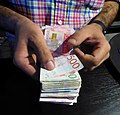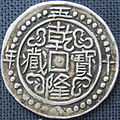Money payment for goods and services and repayment of debts , such as taxes , in a particular country or socio-economic context. The primary functions which distinguish money are: medium of exchange , a unit of account , a store of value and sometimes, a standard of deferred payment .
Money was historically an emergent market phenomenon that possessed intrinsic value as a commodity ; nearly all contemporary money systems are based on unbacked fiat money without use value . Its value is consequently derived by social convention, having been declared by a government or regulatory entity to be legal tender ; that is, it must be accepted as a form of payment within the boundaries of the country, for "all debts, public and private", in the case of the United States dollar .
The money supply of a country comprises all currency in circulation (banknotes and coins currently issued) and, depending on the particular definition used, one or more types of bank money (the balances held in checking accounts , savings accounts , and other types of bank accounts ). Bank money, whose value exists on the books of financial institutions and can be converted into physical notes or used for cashless payment , forms by far the largest part of broad money in developed countries. (Full article...
An intelligent banknote neutralisation system IBNS ) is a security system , that is used by banks, ATMs, retail establishments, vending machines and the cash-in-transit industry, to render stolen funds un-useable and easily identifable. Dye packs are inserted between bills in random bundles. If a bundle containing a dye pack is removed from a specified area (i.e. taken out of bank doors), it explodes, releasing an indelible ink dye and possible array of additional chemicals. The conspicuous bright color (usually red) stains on the bills, allow quick easy visual recognition of stolen money. Tracers and markers can also be added to the ink or bonding agent providing forensic evidence linking the criminal to the crime. Bonding agents (i.e. glues) have been used more recently.
Stained bills cannot be brought back into circulation easily, because they are visually and/or forensically linked quickly to the crime scene. Restricted procedures are globally in place in case of an attempt to exchange them at any financial institutions . (Full article...
The króna krónur ; sign : kr ) is the currency of the Faroe Islands . It is issued by Danmarks Nationalbank , the central bank of Denmark . It is not a separate currency, but is rather a local issue of banknotes denominated in the Danish krone , although Danish-issued coins are still used. Consequently, it does not have an ISO 4217 currency code and instead shares that of the Danish krone, DKK . This means that in the Faroe Islands, credit cards are charged in Danish kroner. The króna is subdivided into 100 oyru(r) Full article...
For editor resources and to collaborate with other editors on improving Wikipedia's Money-related articles, see WikiProject Numismatics
Do you have a question about Money-related content on Wikipedia that you can't find the answer to?
Consider asking it at the Wikipedia reference desk .
The following are images from various currency-related articles on Wikipedia.
Image 2 US dollar banknotes (from
Money )
Image 3 Tibetan silver tangka with Ranjana (Lantsa) script, dated 15-28 (= AD 1894), obverse (from
Tibetan tangka )
Image 4 Paper money from different countries (from
Money )
Image 5 A check, used as a means of converting funds in a
demand deposit to cash (from
Money )
Image 6 Tenga of
Muhammad Khudayar Khan , struck at the Kokand mint, dated 1862–1863 (from
Kokand tenga )
Image 7 Sino Tibetan silver tangka, dated 58th year of Qian Long era, reverse. Weight 5.57 g. Diameter: 30 mm (from
Tibetan tangka )
Image 8 Printing paper money at a printing press in
Perm (from
Money )
Image 9 “Babyal Hoard” type, of the Kuru Janapada (350 - 315 BCE) (from
Punch-marked coins )
Image 10 Tibetan undated silver tangka (2nd half of 18th century) with eight times the syllable "dza" in vartula script, obverse (from
Tibetan tangka )
Image 11 Tibetan undated silver tangka (2nd half of 18th century) with eight times the syllable "dza" in vartula script, reverse (from
Tibetan tangka )
Image 12 Undated Kelzang tangka (1910), obverse (from
Tibetan tangka )
Image 13 A hoard of mostly
Mauryan punch-marked coins (from
Punch-marked coins )
Image 14 Tibetan silver tangka with Ranjana (Lantsa) script, dated 15-28 (= AD 1894), reverse (from
Tibetan tangka )
Image 15 Money Base, M1 and M2 in the U.S. from 1981 to 2012 (from
Money )
Image 16 "Bent bar" of the Gandhara Janapda unearthed with Achaemenid and Greek coins,
Gandhara , c.350 BC. (from
Punch-marked coins )
Image 17 Silver, ½ Karshapana coin, “Babyal Hoard” type, of the Kuru Janapada (450 BC - 315 BC) (from
Punch-marked coins )
Image 18 Gold coins are an example of legal tender that are traded for their intrinsic value, rather than their face value. (from
Money )
Image 19 President
J. K. Paasikivi illustrated in a former Finnish
10 mark banknote from 1980 (from
Money )
Image 20 A person counts a bundle of different
Swedish banknotes. (from
Money )
Image 21 A 1914 British
gold sovereign (from
Money )
Image 22 Tibetan kong par tangka, dated 13-45 (= AD 1791), reverse (from
Tibetan tangka )
Image 23 Tibetan undated silver tangka, struck in 1953/54, obverse. (from
Tibetan tangka )
Image 24 Sino Tibetan silver tangka, dated 58th year of Qian Long era, obverse. Weight 5.57 g. Diameter: 30 mm (from
Tibetan tangka )
Image 25 Song Dynasty
Jiaozi , the world's earliest paper money (from
Money )
Image 26 Tibetan "gaden" Tangka, undated (ca. AD 1840), obverse (from
Tibetan tangka )
Image 27 Huizi currency , issued in 1160 (from
Money )
Image 28 Punch-marked coins discovered from
Chandraketugarh . (from
Punch-marked coins )
Image 29 Undated Kelzang tangka (1910), reverse (from
Tibetan tangka )
Image 30 Tibetan undated silver tangka, struck in 1953/54, reverse. (from
Tibetan tangka )
Image 31 Tibetan "gaden" Tangka, undated (ca. AD 1840), reverse (from
Tibetan tangka )
Image 32 Tibetan kong par tangka, dated 13-45 (= AD 1791), obverse (from
Tibetan tangka )
Image 33 Banknotes of different currencies with a face value of 5000 (from
Money )
Image 35 A 640 BC one-third
stater electrum coin from
Lydia . According to
Herodotus , the
Lydians were the first people to introduce the use of
gold and
silver coins . It is thought by modern scholars that these first stamped
coins were minted around 650 to 600 BC. (from
Money )
26 June 2025 – Anti–money laundering § United States , War on drugs § Mexico The Comisión Nacional Bancaria y de Valores temporarily takes over the management of CIBanco, Intercam Banco, and Vector Casa de Bolsa following allegations of money laundering for drug cartels . (El País)
25 June 2025 – Anti–money laundering § United States , War on drugs § Mexico Mexican banks CIBanco, Intercam Banco, and Vector Casa de Bolsa—the latter owned by Alfonso Romo , former Chief of Staff to President Andrés Manuel López Obrador —are sanctioned by the United States government over alleged money laundering for drug cartels . Mexican president Claudia Sheinbaum requests that the U.S. government provide evidence. (MSN) (Al Jazeera) (Forbes )
Select [►] to view subcategories
Category puzzle
– By region –
North Central East South West
North Caribbean Central South
Currencies of Asia
Central East North South Southeast West
European Union Eastern Southern Western Northern
General Administration Fiscal provisions Economy International status Denominations
Coins by country with minting rights
Adoption by country
Past adoption by
Potential adoption by
History
General Previous EU members
Preceding currencies Former fiscal provisions
– By name –
Circulating Obsolete Proposed As a denomination
Circulating Obsolete As subunit See also
Circulating Circulating, but renamed Obsolete and historical Noncirculating Conceptual Virtual Fictional Private See also
Circulating Obsolete Noncirculating
Circulating Obsolete Private See also
Circulating Obsolete As a denomination See also
Circulating Obsolete As a denomination
Circulating Local alternative currency Obsolete and historical Historical antecedents (mass) See also
Circulating Historical rubles
Circulating Obsolete Conceptual Fictional See also
Circulating Obsolete As subunit See also
19th century 18th century 17th century 15th and 16th centuries See also
– By country –
Canadian currency
Topics Circulating currency
Historical coinage
Banknote series Historical currencies Commemoratives Bullion Pre-confederation Community currencies Other
Current coins Withdrawn coins Banknote series See also
Hong Kong currency
Topics Coinage Banknotes Banknote issuers
Topics CirculatingJapanese yen )
Historical
Historical
Commemoratives
Currency and coinage of the Netherlands
Institutions Banknotes Pre-decimal guilder coins Decimal guilder coins Euro coins See also
New Zealand currency
Currency Coins Banknotes Obsolete denominations
Related topics
Current
Obsolete
Topics Ancient currencies Banknote and coin series
Current Obsolete * Unrecognized
Topics Coins
Currency
Discontinued denominations Discontinued currency types
Related
Topics Coins Banknotes Former currencies Withdrawn coins Withdrawn banknotes
– Historical currencies –
Historical currencies of
Korea
Mun 998–1105, Yang 1892–1902 Won 1902–1910 Yen 1902–1945
Topics Coinage Banknotes Former banknotes
10 bani 25 bani 50 bani 2 lei 3 lei 25 lei 1,000 lei 2,000 lei 5,000 lei 10,000 lei 50,000 lei 100,000 lei 500,000 lei 1,000,000 lei 5,000,000 lei Former coinage
– Other –
The following Wikimedia Foundation sister projects provide more on this subject:
Purge server cache





























































